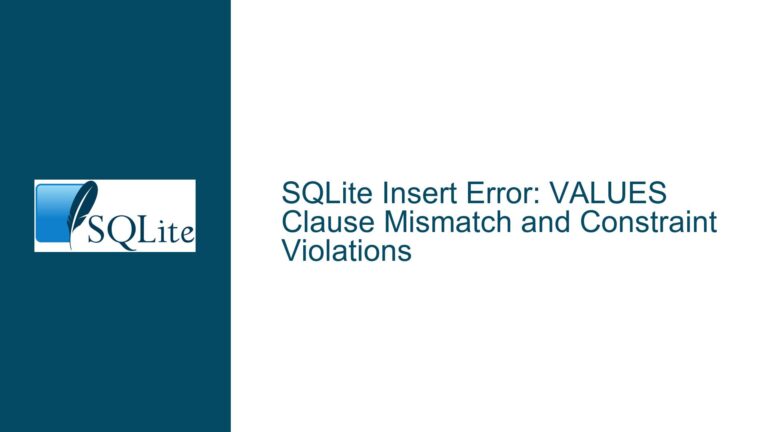Ensuring Reliable Auto-Incrementing Primary Key Retrieval in Concurrent SQLite Environments
Understanding Concurrent Insertions and Auto-Incrementing Key Retrieval Challenges
SQLite’s auto-incrementing primary key mechanism is widely used to generate unique identifiers for new rows. However, retrieving the correct value of this key in concurrent environments—where multiple application instances or connections may perform simultaneous write operations—requires careful consideration of SQLite’s concurrency model, transaction isolation, and API behavior. The core issue arises when developers attempt to retrieve the last inserted row ID using methods like last_insert_rowid() without accounting for how parallel write operations or transaction boundaries affect this value.
SQLite employs a write-ahead log (WAL) or rollback journal to manage concurrent access, but it enforces a strict "one writer at a time" policy. This means that while multiple readers can coexist, only one connection can modify the database at any moment. Auto-incrementing keys are generated using an internal counter managed by SQLite’s sqlite_sequence table (for AUTOINCREMENT-enabled tables) or via the implicit ROWID mechanism. The last_insert_rowid() function returns the most recently generated ROWID for the current database connection, not globally across all connections.
The challenge occurs when a client inserts a row and attempts to retrieve its key while other clients are actively writing to the same table. If transactions are not properly managed, a subsequent write from another client could alter the last_insert_rowid() value before the first client retrieves it. This creates a race condition where the retrieved ID may not correspond to the intended row.
Root Causes of Incorrect Auto-Incrementing Key Retrieval
1. Misuse of last_insert_rowid() Without Transaction Isolation
The last_insert_rowid() function is connection-specific, meaning it reflects the last ROWID generated by the current connection. However, if a transaction is not explicitly defined, SQLite operates in autocommit mode, where each INSERT statement is treated as a separate transaction. In this scenario, the write lock is released immediately after the INSERT completes. If another client acquires the write lock and performs an insertion before the first client calls last_insert_rowid(), the returned value will reflect the second client’s ROWID, not the first.
For example, consider two clients (Client A and Client B) inserting rows into the same table:
- Client A executes
INSERT INTO table (column) VALUES ('data');(autocommits). - Client B acquires the write lock, executes its own
INSERT, and autocommits. - Client A calls
SELECT last_insert_rowid();but receives Client B’sROWIDbecause Client A’s connection was not isolated within a transaction.
2. Lack of Atomicity in Multi-Statement Operations
Developers often concatenate INSERT and SELECT last_insert_rowid() into a single sqlite3_exec() call, assuming atomicity. However, SQLite executes each statement sequentially, and autocommit mode commits after each statement. This means the INSERT and SELECT are separate operations, allowing another client to interleave a write between them. Even though SQLite serializes writes, the absence of an explicit transaction allows the last_insert_rowid() value to be overwritten by another client’s insertion.
3. Failure to Use the RETURNING Clause for Immediate Key Retrieval
SQLite 3.35.0 introduced the RETURNING clause, which allows developers to retrieve the auto-generated ROWID (or any column) directly from the INSERT statement. This method is atomic and immune to interleaved writes because the INSERT and RETURNING are executed as a single operation. Not using this feature in supported SQLite versions forces developers to rely on error-prone secondary queries.
4. Incorrect Assumptions About Connection-Specific Behavior
The last_insert_rowid() function is tied to the database connection, not the table or the application. If a connection pool is used, a different physical connection might handle subsequent requests, leading to incorrect ROWID retrieval. For example, an application that inserts a row via Connection 1 and attempts to retrieve the ROWID via Connection 2 will receive the last ROWID generated by Connection 2, which could be unrelated.
Strategies for Reliable Auto-Incrementing Key Retrieval in Concurrent Workloads
1. Leverage Explicit Transactions to Isolate Write Operations
Wrap the INSERT and last_insert_rowid() operations within an explicit transaction to prevent interleaved writes:
sqlite3_exec(db, "BEGIN TRANSACTION;", 0, 0, 0);
sqlite3_exec(db, "INSERT INTO table (column) VALUES ('data');", 0, 0, 0);
sqlite3_exec(db, "SELECT last_insert_rowid();", callback, 0, 0);
sqlite3_exec(db, "COMMIT;", 0, 0, 0);
This ensures that the write lock is held until the transaction commits, blocking other writers from modifying the database until the ROWID is retrieved.
2. Use the RETURNING Clause for Atomic Insertion and Retrieval
For SQLite versions ≥ 3.35.0, append RETURNING rowid to the INSERT statement:
sqlite3_exec(db, "INSERT INTO table (column) VALUES ('data') RETURNING rowid;", callback, 0, 0);
The RETURNING clause guarantees that the auto-generated ROWID is returned as part of the same statement execution, eliminating the risk of interleaved writes.
3. Avoid Connection Pooling Pitfalls
Ensure that the same database connection is used for both the INSERT and last_insert_rowid() operations. If connection pooling is unavoidable, configure the pool to reserve a connection for the duration of the transaction.
4. Prefer Implicit ROWID Over AUTOINCREMENT When Possible
SQLite automatically assigns a ROWID to every row, which can be referenced using an INTEGER PRIMARY KEY column. Explicit AUTOINCREMENT should only be used when preventing ROWID reuse is critical (e.g., for audit trails). The AUTOINCREMENT keyword incurs overhead by querying the sqlite_sequence table, whereas implicit ROWID generation is faster and equally reliable for most use cases.
5. Validate SQLite Version and Feature Compatibility
Before relying on the RETURNING clause, verify that the SQLite library linked to the application is version 3.35.0 or newer. Use the sqlite3_libversion() function to check the runtime version.
6. Handle Edge Cases with WITH Clause or Temporary Tables
For complex workflows requiring multiple dependent inserts, use Common Table Expressions (CTEs) or temporary tables to store intermediate ROWID values:
WITH inserted AS (
INSERT INTO parent (name) VALUES ('Parent') RETURNING rowid
)
INSERT INTO child (parent_id, name)
SELECT rowid, 'Child' FROM inserted;
This ensures that the ROWID from the first insertion is safely reused in subsequent operations.
7. Monitor for Transaction Deadlocks and Timeouts
In high-concurrency environments, transactions may fail due to lock contention. Implement retry logic with exponential backoff to handle SQLITE_BUSY errors. Configure busy timeouts using sqlite3_busy_timeout() to allow SQLite to automatically retry locked operations.
8. Test with Parallel Workload Simulations
Use stress-testing tools or scripts to simulate concurrent inserts and verify that ROWID retrieval remains accurate. For example, spawn multiple threads or processes that perform inserts and key retrievals, logging discrepancies for analysis.
By combining explicit transactions, atomic RETURNING clauses, and careful connection management, developers can reliably retrieve auto-incrementing primary keys even in highly concurrent SQLite environments.






